Optimizing Your Outsourced Contact Center with AI

Contact centers have evolved from single-channel, telephone-based call centers to “omni-channel” communication hubs supporting a variety of telephone, video, texting, web, and social media channels. They are also establishing better mechanisms to support their traditional live interactions. With the expansion of customer interactions across these many channels, companies are recognizing that they must impart a consistent messaging approach and are adopting principles of a unified communication capability (UCC) to achieve success. Simultaneously, artificial intelligence (AI) has offered companies new tools to manage this increasingly complex communication ecosystem.
Contact centers are at the crossroads of omni-channel adoption and AI enablement and are reinventing themselves to enrich their value proposition.
Contact centers have been a business function that companies have often outsourced and/or offshored. The introduction of omni-channel services and AI enablement drastically changes the value proposition of outsourcing and offshoring contact centers. This article discusses how AI is changing the omni-channel contact center and why and how you should look at your outsourcing and offshoring arrangements to capitalize on this game-changing transformation.
The operational improvements that AI enablement can make to the contact center service delivery model can dramatically reduce your dependence on outsourced and offshore labor and may even be sufficient to enable you to insource and onshore your contact center. Conversely, if you have not outsourced or offshored your contact center, AI may incentivize you to move in that direction. The time to act on reenabling your contact center service delivery model is now.
The role of contact centers in the customer experience
The earliest known customer complaint was by a customer named Nanni, who complained to his supplier, Ea-Nasir, that he was shipped the wrong grade of copper ore and that a separate shipment was misdirected and delayed. The translation happened in the city of Ur, Mesopotamia, about 3,800 years ago.
Included in the message is the often-used customer complaint, “What do you take me for, that you treat somebody like me with such contempt?” It is not known whether Ea-Nasir rectified this complaint; apparently, he had many dissatisfied customers.
I suspect that Nanni is still waiting.
In more contemporary times, retailers began to accept returns in the 1850s when Rowland Hussey Macy opened the first department store, R.H. Macy & Co. Retailers established dedicated return departments to handle customer complaints and returns in the 1920s. These return departments evolved into contact centers.
Contact centers have a long history of using technology to improve their business operations. The timeline below describes the history of the contact center.

Contact centers initially emerged from centralized offices where customer service representatives handled large call volumes at the company’s physical location (“on-prem”). Their primary function was to manage inbound and outbound calls related to sales, support, and inquiries. While effective in its time, this model focused solely on voice communication and often faced challenges such as long wait times and limited customer interactions. Now, cloud-based contact center management systems have granted representatives the ability to work virtually, and contact centers address a wider range of interactions that are known as “customer touchpoints.”
The key customer touchpoints enhancing the customer journey
The diagram below represents the four channels that companies are using to reach out to and be reached by their customers. These loci of interactions are called “touchpoints.”
DIAGRAM 1 — Touchpoint wheel for AI-enabled customer journeys
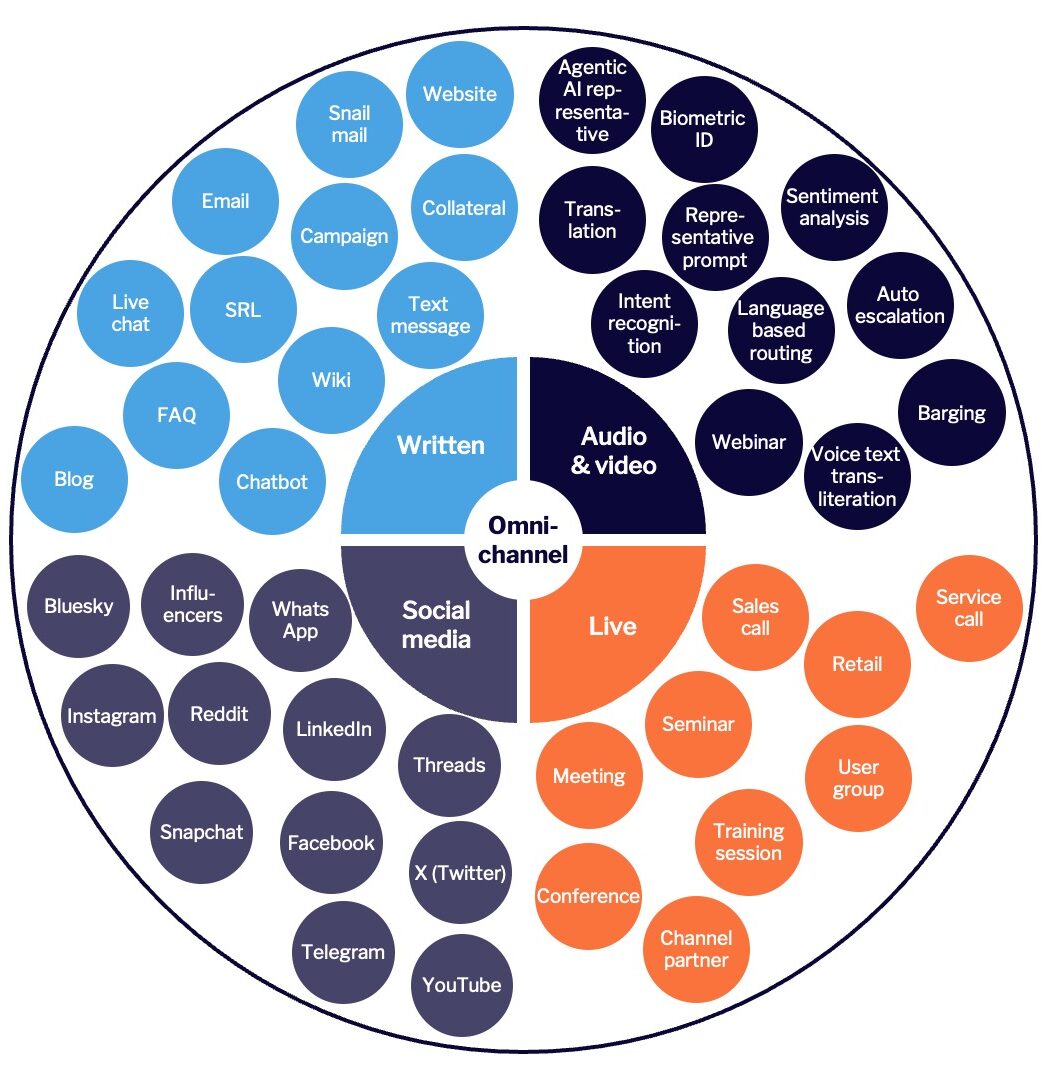
Companies are enhancing these four channels with AI — and with autonomous agentic AI representatives, avatars that mimic human customer service representatives — to better interact with their customers:
- The written channel has evolved from static (using collateral materials and snail mail correspondence) to active (relying on websites, blogs, and emails). As such, the control of the message requires instantaneous structuring and confirmation. AI enables messages to be instantly verified against a pre-defined knowledge base.
- The audio and video channel has evolved from the automatic call distribution PBX to AI-empowered call routing that can decipher the customer’s verbal query, assess the query’s content and the caller’s emotion and intent, and route it to the most appropriate representative. Companies can now replace live representatives with agentic AI representatives to reduce labor costs. Some companies are also moving from phone conversations to video conferencing for an improved user experience.
- The social media channel is a new form of communication for companies and has become a critical means of both client communication and advertising. Click-throughs on banner ads or other hyperlinks can now connect the user to a dynamic encounter with a live representative or an agentic AI representative. Active encounters on social media sites are being hosted by company personnel or agentic AI representatives.
- Encounters in the live channel were historically captured after the fact, if at all. Sales and service calls, previously supported by a call to the home office for pricing, inventory, or scheduling purposes, are now supported dynamically through the CCM system into the CRM or enterprise system. Sales calls and customer meetings conducted via video are automatically transcribed and assessed by AI-enabled applications and attached to the customer record.
Companies have found that, with so many diverse avenues of customer communications, it is important to implement a unified communication capability for consistent messaging. AI can provide a guardrail to enforce consistent responses in these encounters. For companies in regulated industries such as pharmaceuticals, it is critical that the messages are consistent as they fall under the auspices of their internal compliance mechanisms. Across industries, companies recognize that consistency across communication channels strengthens their brand identity and enhances their encounters with their customers.
The level of contact center sophistication has evolved to where the primary concern is no longer just how quickly the call is answered, but how well the customer interacts with the services that are provided. The flow of this interaction is described as the “customer journey.”
The progression of the customer journey
Modern customer journeys are increasingly complex, as the customer may travel along several different routes as they seek the answers to their questions. AI can contribute to the customer’s experience by improving the performance of live representatives and the quality of their responses with AI-enabled applications. AI can alternatively provide the customer with a new mode of interaction: the agentic AI representative.
For example, a customer who is at home has some questions about a product that they intend to buy. They have two options: they can call the company contact center, or they can browse the company website and even initiate a webchat on the website should they so desire. Should the customer not be satisfied with their experience during a web voice chat with a live representative, they can be rerouted by an AI app to a voice call with that live representative or a more experienced live representative. Should the live representative want to transfer the encounter from their web voice chat to a telephone call, they can reroute the call to a telephone call-back with the customer or a call-back from a more appropriate live representative. Should the customer not be satisfied with their experience during a web text chat (web bot) or a web voice chat (call bot), the customer can elect to be rerouted to a voice call-back with a live representative. The AI-enabled app can also monitor the encounter and recognize an unacceptable level of customer dissatisfaction and, with the customer’s approval, reroute the encounter to a telephone call-back with a live representative. If no customer telephone number is available, the live representative can conduct the call over the web, but it is more likely that if the customer is unhappy with their experience over the web, they would prefer a live telephone call.
DIAGRAM 2 — Customer journey
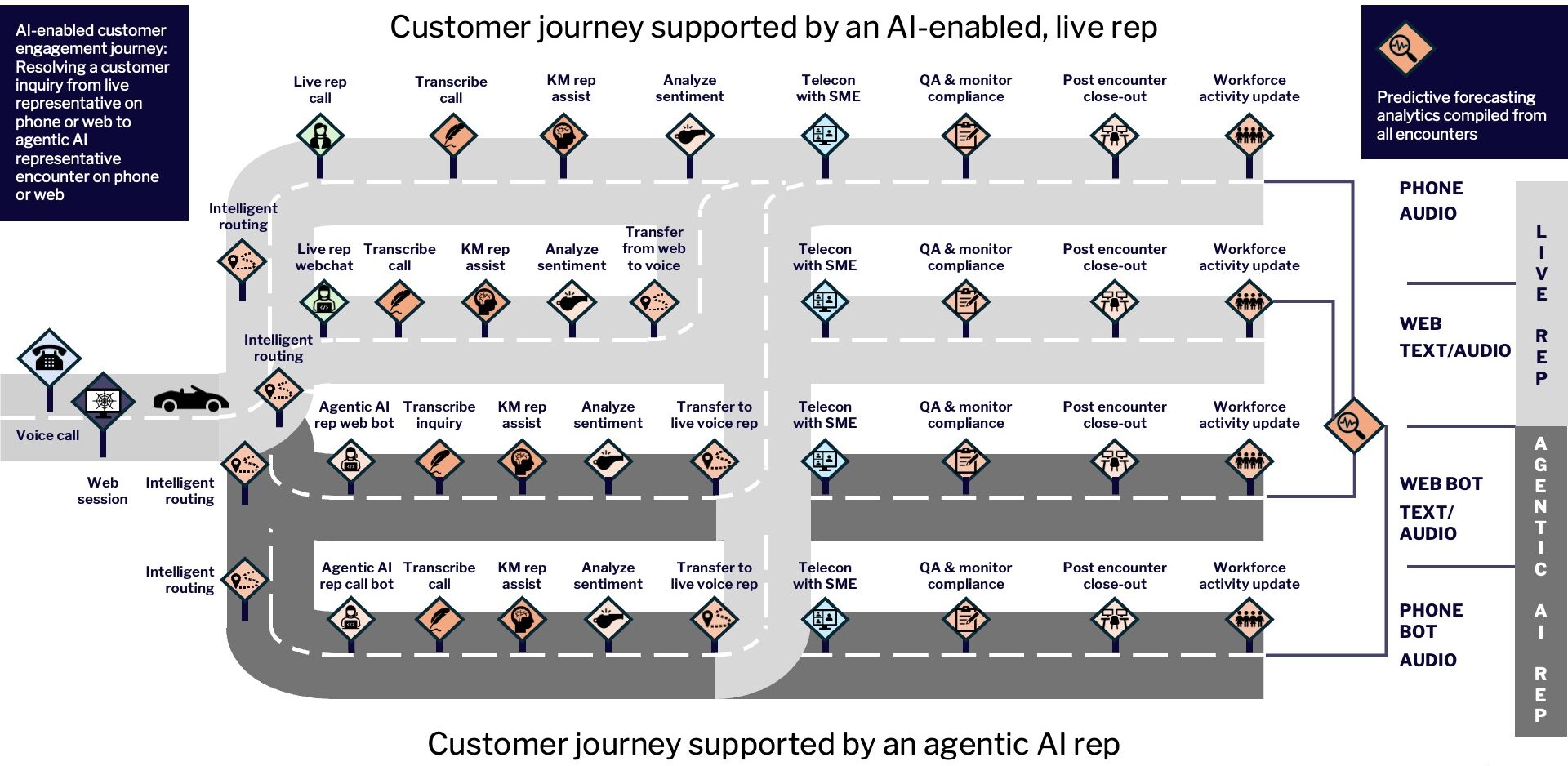
The diagram shows the four routes companies commonly build to interact with customers over written (website) or audio and video (telephone) channels:
- A phone call with the customer that is processed by an AI-enabled live representative (audio)
- A web session with the customer that is processed by an AI-enabled live representative (audio or text)
- A web session with the customer that is processed by an agentic AI representative (audio or text)
- A phone call with the customer that is processed by an agentic AI representative (audio)
With a wide variety of different encounters and types of activities along the customer journey, AI is contributing in many different ways, both along routes where the customer interacts with a live representative and along those where they interact with an agentic AI representative. This includes:
- AI-enabled conversational interactive voice response systems using natural language understanding (NLU) to analyze encounters to determine the customer’s intent, with contextual awareness to determine the nature of the call and whether the customer has previously contacted the company
- AI-enabled biometric identification can identify the caller and provide information for account access
- AI-enabled automatic call routing systems to determine the most appropriate live representative to respond to the call, balancing availability, capabilities, and the customer’s priority level and intent, while also recommending appropriate responses/actions
- AI-enabled website routing to determine whether there is an answer available that the customer has not yet navigated to and take appropriate next steps to deliver an answer or start an interactive chat session with the customer
- AI-enabled real-time transcription, translation, and recordings
- AI-enabled speech analytics to understand customer sentiment and flag potential customer dissatisfaction
- AI-enabled querying to provide representatives with guidance and relevant examples from similar customer interactions
- AI-enabled Erlang C models and representative performance metrics with real-time data analysis for performance tracking and workforce management
- AI-enabled post-encounter workflows and automations to record and analyze customer encounters and store data in relevant applications
The term “AI enablement” is the new defining principle that can be compared to “computer automation,” coined by John Diebold, which originated many of the concepts of data processing and computer utilization that are accepted today in both automation and management. AI enablement — using machine learning, natural language processing, large language models, deep learning, generative AI, conversational speech synthesis, computer vision, robotics, and predictive analysis — is enabling contact centers to evolve from automated call distributors and isolated customer relationship management systems into comprehensive, integrated platforms that improve the company’s ability to interact with its community.
The impact of AI on the contact center tech stack
To better understand how AI-enabled technologies have transformed the contact center, we need to identify its tech stack — the compendium of software, applications, and systems that comprise its technology framework. The AI-enabled tech stack comprises five layers:
- Enterprise layer: This layer consists of legacy and core business support systems. A system of record for data and transactions used by multiple applications. It represents an overarching application framework.
- Customer relationship management layer: This layer is the system of record for all customer interactions across all channels. It may also be used to track non-customer encounters, interactions with suppliers, PR contacts, and partners.
- Contact center management layer: This layer manages and optimizes customer communications across all channels. It provides the pathway for the customer journey and manages the workflow in the contact center.
- Security layer: Providing customer access to corporate systems through the contact center introduces potential security concerns. Data breaches, ransomware attacks, and identity-based impersonation attacks must be guarded against as the contact center comes to provide increased, unfettered access to the company’s internal systems. These risks are allayed through a strong security layer.
- Communications layer: This layer consists of the various means of communicating with the organization. It maintains the interfaces and integrations of the network architecture that facilitates the exchange of data into company systems, in/out of SaaS applications, and between internal systems and applications.
Interfaces and integrations operate between the layers to bind them together.
Diagram 3 describes the technologies that build each of these layers.
DIAGRAM 3 — Tech stack landscape for an omni-channel contact center
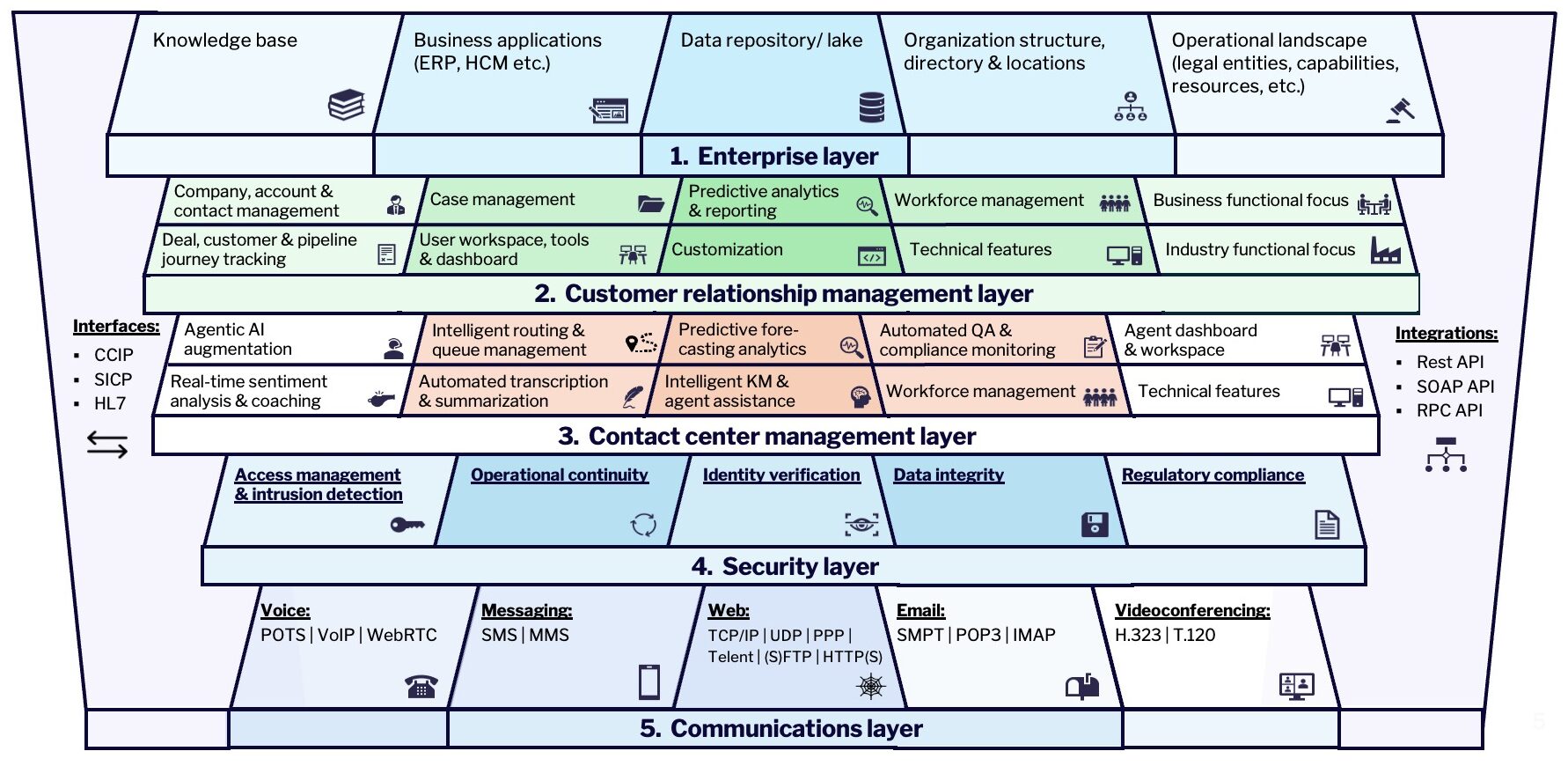
On-premises PBX telephone systems and automated call distribution systems are being replaced by cloud-based contact center management systems that are provided as a service (CCaaS) or unified communications as a service (UCaaS). The client encounters that flow across these services are enhanced by AI-based language translation services that benefit the business by reducing the time and costs associated with live translators and enriching customer satisfaction. Across the contact center management layer alone, there are broad opportunities to improve workflows and outcomes via AI.
Diagram 4 drills down into the contact center management layer.
DIAGRAM 4 — Contact center management tech stack layer
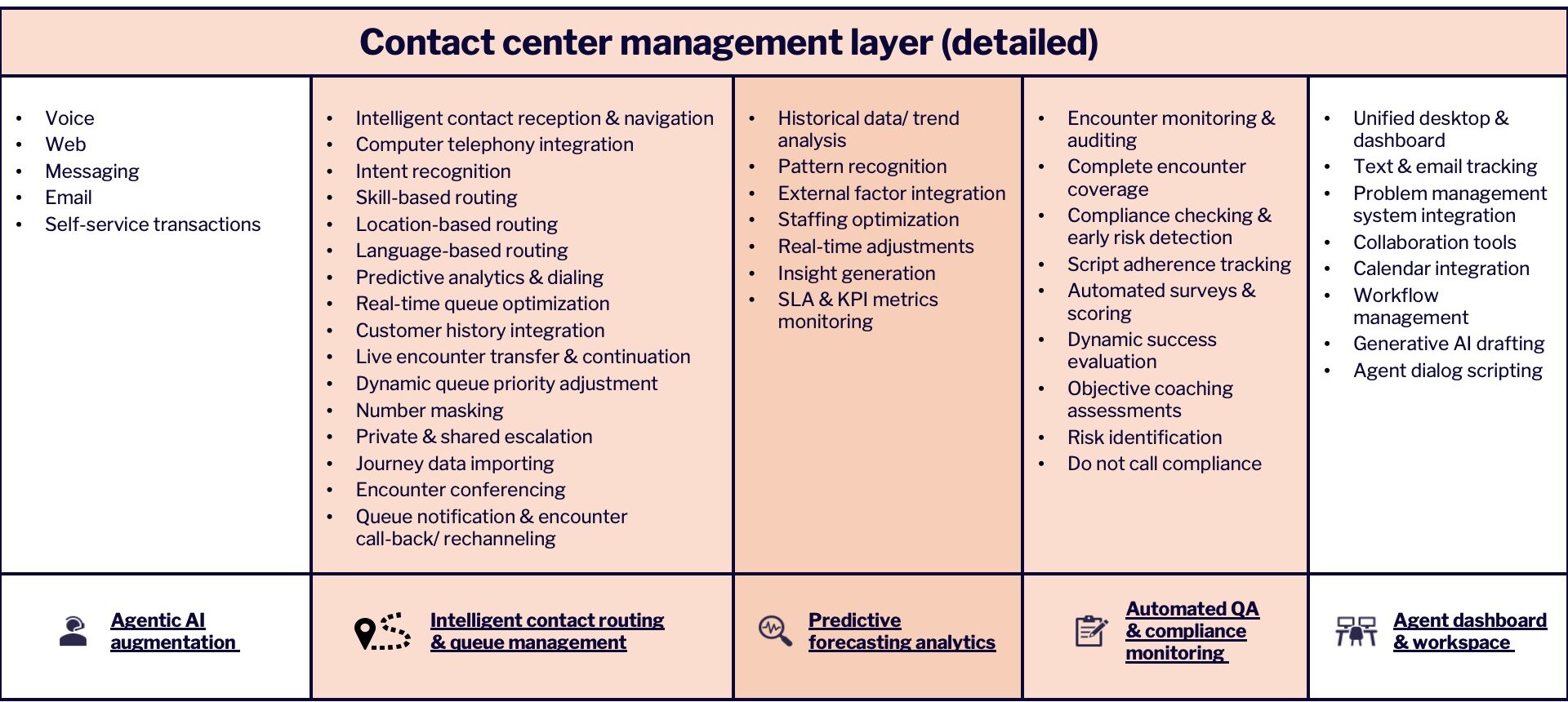
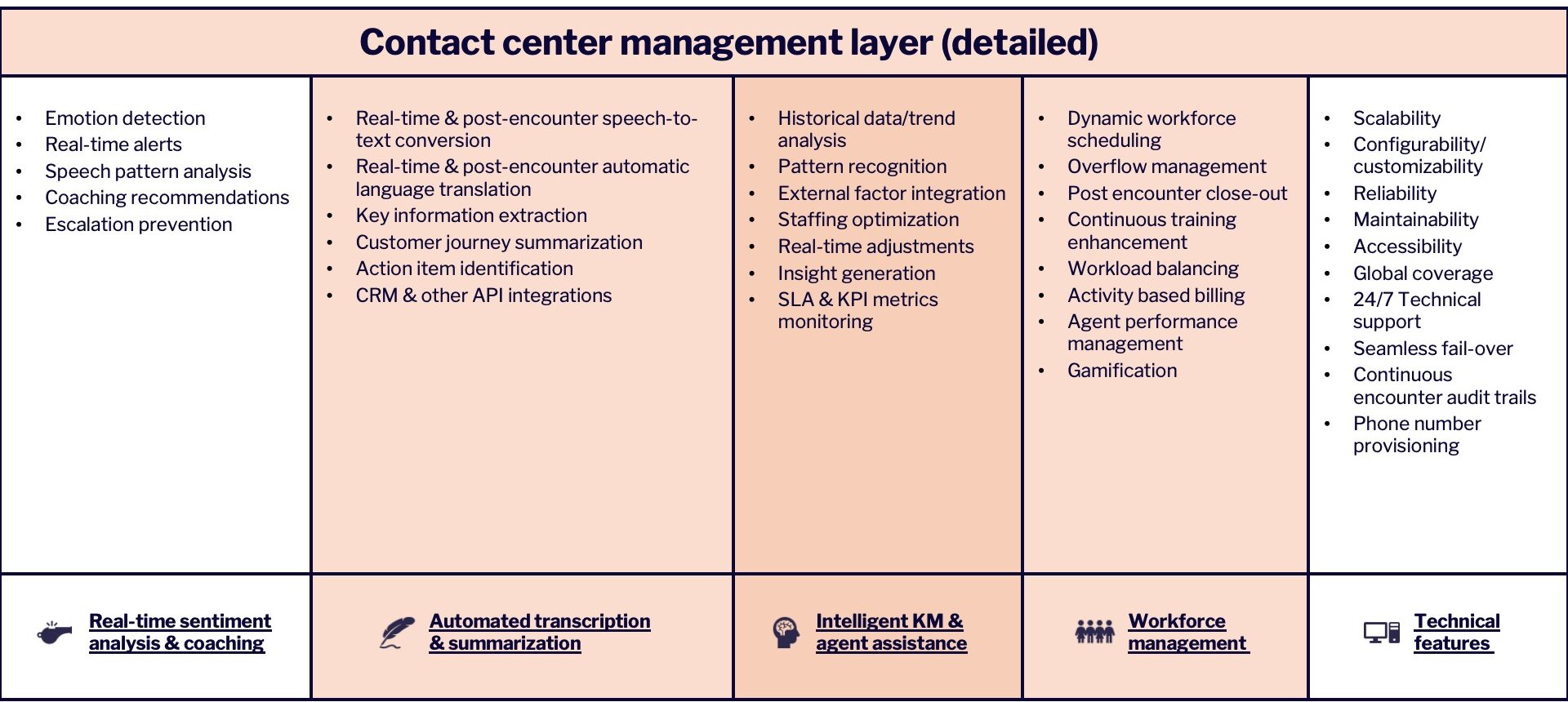
The future of outsourced contact center services
Companies are changing the way that they view what their contact centers can do and how they should be delivering contact center services. Companies are recognizing that good customer service practices are a benefit to their bottom line. Effective contact center services:
- Improve customer retention, reducing the cost of getting customers back
- Reduce the cost of sales
- Reduce the cost of delivering services
Outsourcing, and especially offshoring, has long been seen as the preferred delivery model of contact center services. As the value of the contact center to the company and the value proposition of outsourcing change, the way that companies contract for contact center outsourcing must be re-examined.
Companies outsource to reduce costs, remove distractions from non-core competencies, free internal resources, overcome insufficient internal resources, and gain access to superior technical and/or operational capabilities. Outsourcing service providers often take advantage of global labor arbitrage costs, i.e., offshoring. Many consider offshoring synonymous with outsourcing, but it is not; outsourcing arrangements are not always offshore, and many companies own their own operations in countries on “all shores” across the globe.
Some companies have experienced customer dissatisfaction with the delivery of offshore contact centers because customers feel that assistance is being provided through a faceless voice with a strange and incomprehensible accent that lacks a clear understanding of the solution to the problem. This has caused some companies to reshore their contact centers to the location of their primary customer base. Privacy concerns have also restricted the use of offshore resources to deliver contact center services when they violate restrictions for international cross-border data transactions.
The pricing model for outsourced contact center services is a key component of their value proposition. The pricing model for outsourced services typically has three pricing alternatives:
- Cost per call
- Cost per contact center representative (seat cost)
- Cost by service delivery level (SLA)
One technique that outsourcing service providers have used for decades to reduce their internal cost of delivery is to automate requests that could be easily addressed through a “self-help” application. For example, if users frequently request help resetting account passwords, an outsourcing service provider may engineer these requests to be fulfilled through a self-help capability. The cost to the provider of developing this self-help reset capability is easily amortized over the reduction in live representative encounters. If the company’s service agreement did not call out the cost reduction implications of these types of automations, the service provider can profit from automating these simple requests, especially where pricing was on a per-call basis with no distinction between live and self-help calls. A well-constructed service agreement would share the productivity gain between the customer and the service provider and reduce the cost of the services provided to the customer.
The introduction of AI-enablement into the contact center and its concomitant reduction in the cost of delivering these services has occurred so rapidly that the market, and most contact center service agreements, have not yet had time to adjust to this major productivity improvement.
As companies redefine their customer engagement journey using AI, they can change the services offered as well as their delivery. Extending the hours of operation, expanding the services delivered through contact centers, improving the sales pipeline, reducing customer dissatisfaction, and improving customer and product knowledge can now be addressed through AI-enabling technologies. AI is changing the equation on the most effective mechanisms for delivering contact center services.
Organizations are recognizing that their contact centers are becoming the face of the company. They are beginning to understand the importance of investing in contact center services and are realizing that AI-enablement technologies are a critical component of their brand identity. As AI can reverse the dependence on outsourcing functions that benefit from lower labor costs, this trend to consider offshoring as the most cost-effective solution may reverse. AI has introduced an interesting paradox:
Companies that have outsourced and offshored their contact centers should investigate whether AI enablement changes the value proposition of using outsourced and offshored contact center services. Companies that have not outsourced their contact center services should explore whether outsourcing and offshoring contact center services using AI-enabling technologies can now both provide them with a competitive advantage and a more efficient and cost-effective delivery model.
By embracing these innovations, businesses can deliver exceptional service experiences that foster lasting loyalty.
A careful impact assessment that includes all stakeholders who depend on and are responsible for these services can help you to understand how to best prepare your company for the impact of the AI revolution on your contact center.
Determining the effects of AI on outsourced contact center services
The diagram below presents the key elements of an impact assessment of AI-enablement technologies on outsourced contact center services.
DIAGRAM 5 — AI impact assessment of outsourced contact center services
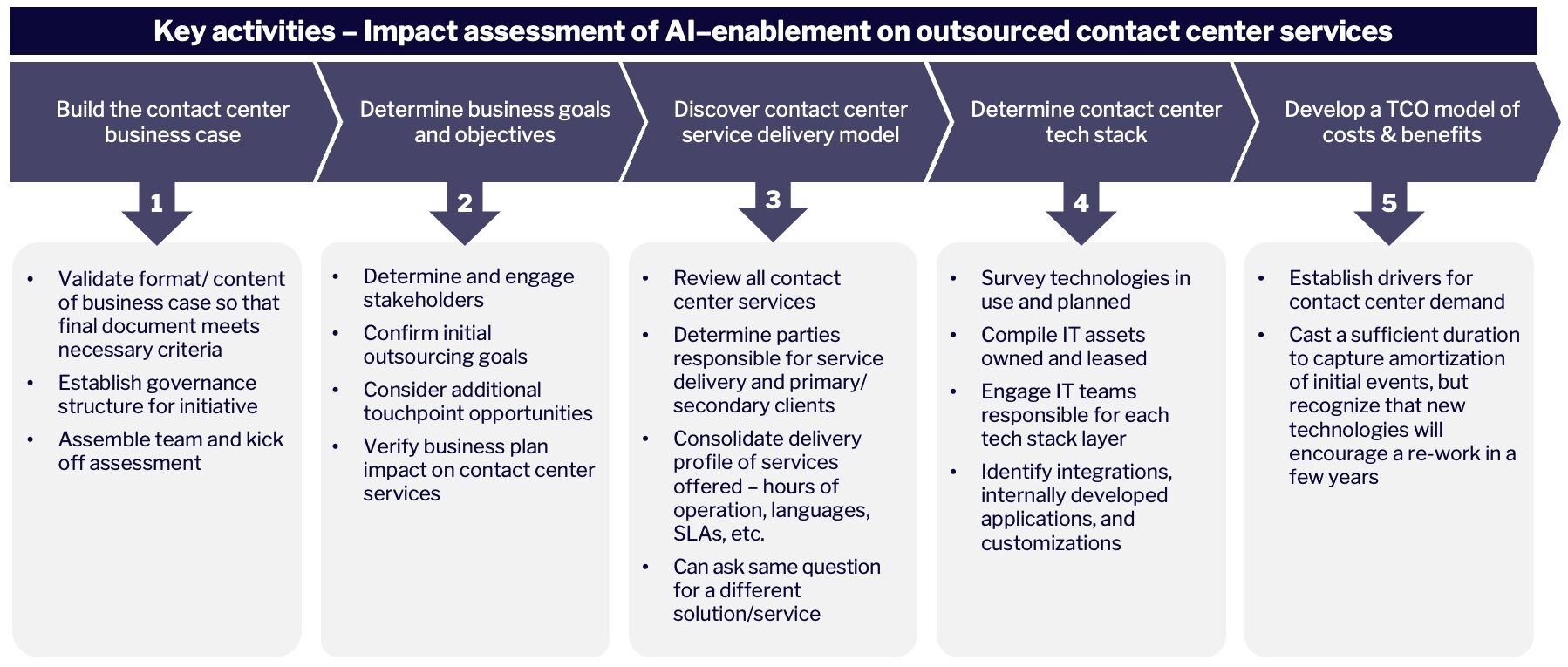

As with all transformational initiatives, it is important that you have a program champion, corporate commitment, adequate budget and resources, sufficient time, and a clear runway that guards against other business initiatives that could negatively impact this assessment. If there are extenuating circumstances that could interfere with the assessment, such as the expiration of the outsourcing agreement with your current service provider, a product launch that will tax your current contact center, or opening offices in new countries, they must be taken into account when considering the timeframe and level of effort necessary to ensure a successful outcome.
If you find that your contact center service provider is reluctant to help you determine how you can best take advantage of AI-enablement technologies, you may be working with the wrong service provider. AI-enablement technologies are changing what a contact center can do and how it can do it. Once you have explored the use of AI-enablement technologies in the contact center, you can bring these technologies into other areas of your company’s operations to maximize the benefits they can provide to your organization.
Is your contact center strategy optimized for efficiency and cost?
We can helpMeet the Author
Mitchell H. Goldstein is a Catalant Expert and Managing Director of the Productivity Center, where he counsels public, private, and non-profit clients in the use of new IT technologies. With more than 30 years of IT consulting experience, Mitchell’s expertise spans all phases of the systems development lifecycle and includes deep knowledge of information system management from a business perspective and the financial/service impact of outsourcing. He holds a Master of Public Administration in Information Systems and Public Finance from Cornell University and a Bachelor of Arts from the University of Rochester.












